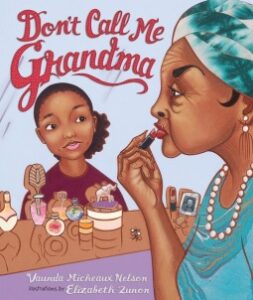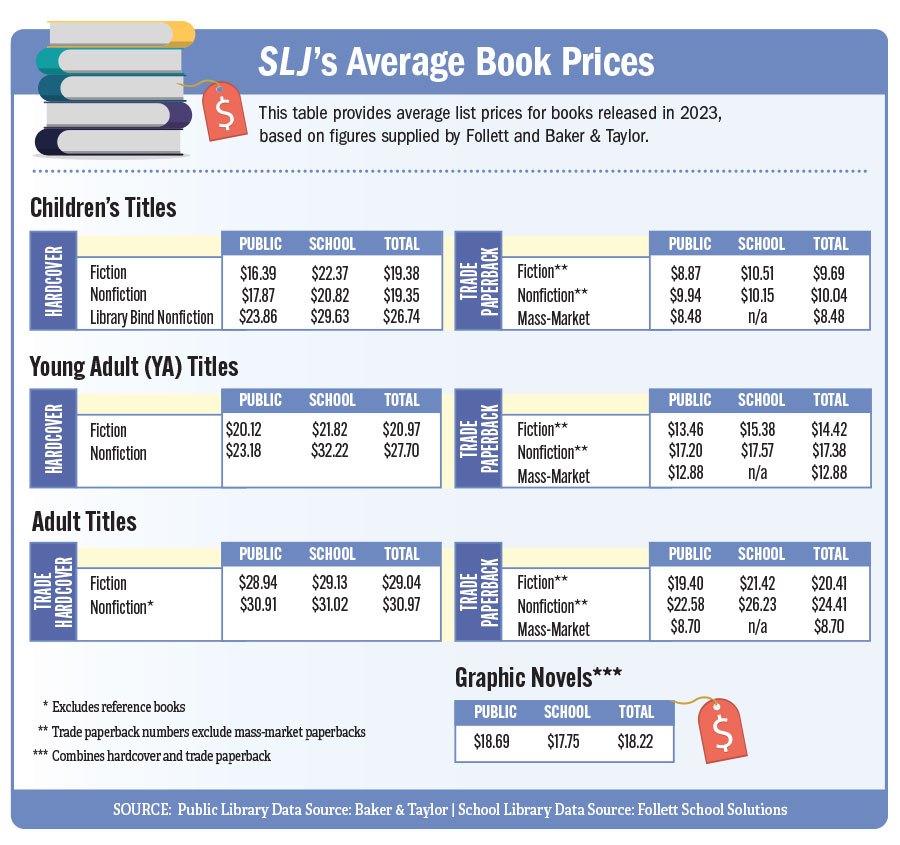Review of the Day: Don’t Call Me Grandma by Vaunda Micheaux Nelson
 Don’t Call Me Grandma
Don’t Call Me Grandma
By Vaunda Micheaux Nelson
Illustrated by Elizabeth Zunon
Carolrhoda Books (a division of Lerner)
$19.99
ISBN: 978-1-4677-4208-5
Ages 4-7
On shelves now.
In 2016 a picture book won a Newbery Award. Which is to say, a picture book was declared the best-written work for children between the ages of 0-14. After its win there was a fair amount of speculation about what precisely the Newbery committee was trying to say with their award. For that matter, there was a fair amount of speculation about what it meant for children’s literature in general. Are we, as a people, less tolerant of loquacious books? Considering the fact that a book with 592 pages was a runner-up, I think we’re doing just fine in terms of wordy titles. Just the same, I hope that if anything comes out of this surprise award it’s a newfound appreciation for the picture book’s art of restraint. A good picture book shows but doesn’t tell. Don’t believe me? Read the original manuscript of Sendak’s Where the Wild Things Are where he spells everything out for the reader. All these thoughts were in my head recently when I read the remarkable Don’t Call Me Grandma by Vaunda Micheaux Nelson. Tackling the almost nonexistent subcategory of grouchy great-grandparents, Ms. Nelson deftly encapsulates a woman’s personality and lifetime of experiences in a scant 32 pages.
“Great-grandmother Nell is scary.” You got that right, kid. She also does not hug, or kiss, or chase her great-grandchild for fun. Instead she sips an intoxicating beverage from a glass bedecked with a spider. She serves up fish for breakfast, buggy eyes and all. But she also has a vanity full of mysterious perfumes, lipstick as red as rubies, and memories as sharp and painful as the day they were made. And when her great-granddaughter sneaks a kiss, Nell is still scary. But that’s okay. “…I like her that way.”
ADVERTISEMENT
ADVERTISEMENT
 First and foremost, this is not a fuzzy grandparent (or great-grandparent) book. There are plenty of fuzzy books out there, filled to brimming with warm snuggly feelings. If that is the kind of book you require then grab yourself the nearest Nancy Tillman and content yourself accordingly. What we have here instead is a kind of character study. Whatever expectations you carry into this book, they will be upended by the text. Nell is an amazing character, one that I’ve never seen in book of this sort. Her prickly nature may well hide that “broken heart” she mentions obliquely, but it could just as easily hide more prickles. We get three distinct memories of her past, but it’s a single wordless two-page spread that probably says more about her than anything else. As an adult, I found myself speculating about her life. How perhaps she had dreams of dancing professionally but that she put those dreams aside when she had her children at a very young age. No kid is going to read into Nell what I have. That’s what makes reading this book so dynamic. Come for the prickly relative. Stay for the enticing, unknowable back story.
First and foremost, this is not a fuzzy grandparent (or great-grandparent) book. There are plenty of fuzzy books out there, filled to brimming with warm snuggly feelings. If that is the kind of book you require then grab yourself the nearest Nancy Tillman and content yourself accordingly. What we have here instead is a kind of character study. Whatever expectations you carry into this book, they will be upended by the text. Nell is an amazing character, one that I’ve never seen in book of this sort. Her prickly nature may well hide that “broken heart” she mentions obliquely, but it could just as easily hide more prickles. We get three distinct memories of her past, but it’s a single wordless two-page spread that probably says more about her than anything else. As an adult, I found myself speculating about her life. How perhaps she had dreams of dancing professionally but that she put those dreams aside when she had her children at a very young age. No kid is going to read into Nell what I have. That’s what makes reading this book so dynamic. Come for the prickly relative. Stay for the enticing, unknowable back story.
What I would really like to praise in this review, if nothing else, is just how deftly author Vaunda Micheaux Nelson parses words into sentences that swell with meaning. Take, for example, the moment when our heroine enters Great-Grandmother Nell’s bedroom. She considers playing with the cloth ballerina on the best but abstains, saying, “her expression makes me think she might tell.” Later she kisses her great-grandmother in her sleep. “Even asleep, Great-Grandmother Nell is scary. But I like her that way.” The very last line? “She won’t know”. It would be fascinating to see Nelson’s original manuscript. Was it just this sparse and spare? Or was it much longer and cut down to the bone in the editing process? Whichever it was, it works.
 The child in this book is much like the child who will be reading it with an adult. Both she and they sense that there is more at work here than meets the eye. And it is the art by Elizabeth Zunon that backs that feeling up. Elizabeth Zunon has been a force to reckon with for years. I first noticed her when she illustrated William Kamkwamba’s The Boy Who Harnessed the Wind, though I unknowingly had already been a fan of hers when she illustrated Jeanne Harvey’s My Hands Sing the Blues. In Don’t Call Me Grandma she begins with a straightforward contemporary story. Even then, her endpapers start telling the tale long before the words do (not counting the title). She fills these early pages with strings of pearls. Fat pearls, small pearls, pink and gray and white pearls. Note that in the text there is just one mention of those pearls, and it’s in the context of a lot of other things on Nell’s dressing table. But Zunon is getting a grip on her personality in her own way. Because of her we get a distinct sense of Great-Grandmother’s style, poise, and dignity. There are fun little details too, like the family peering out through the window as Nell gives a singing bird what for and how to. Zunon also lends Nell a humanity on the sidelines. When her great-granddaughter looks around her room we see Nell observing affectionately from the sides (though she’d be the first to deny it if you accosted her with the evidence). Then there are the memories. Depicted as splotchy watercolors, Zunon subtly changes her style to indicate how some memories are crystal clear even as they blur and go soft around the edges. The two-page spread of objects representing other memories (everything from photographs of Civil Rights marchers to tickets to an Alvin Ailey ballet) will require giving child readers some context. Nothing wrong with that. Sit them down and explain each thing you see. Don’t recognize something? Look it up!
The child in this book is much like the child who will be reading it with an adult. Both she and they sense that there is more at work here than meets the eye. And it is the art by Elizabeth Zunon that backs that feeling up. Elizabeth Zunon has been a force to reckon with for years. I first noticed her when she illustrated William Kamkwamba’s The Boy Who Harnessed the Wind, though I unknowingly had already been a fan of hers when she illustrated Jeanne Harvey’s My Hands Sing the Blues. In Don’t Call Me Grandma she begins with a straightforward contemporary story. Even then, her endpapers start telling the tale long before the words do (not counting the title). She fills these early pages with strings of pearls. Fat pearls, small pearls, pink and gray and white pearls. Note that in the text there is just one mention of those pearls, and it’s in the context of a lot of other things on Nell’s dressing table. But Zunon is getting a grip on her personality in her own way. Because of her we get a distinct sense of Great-Grandmother’s style, poise, and dignity. There are fun little details too, like the family peering out through the window as Nell gives a singing bird what for and how to. Zunon also lends Nell a humanity on the sidelines. When her great-granddaughter looks around her room we see Nell observing affectionately from the sides (though she’d be the first to deny it if you accosted her with the evidence). Then there are the memories. Depicted as splotchy watercolors, Zunon subtly changes her style to indicate how some memories are crystal clear even as they blur and go soft around the edges. The two-page spread of objects representing other memories (everything from photographs of Civil Rights marchers to tickets to an Alvin Ailey ballet) will require giving child readers some context. Nothing wrong with that. Sit them down and explain each thing you see. Don’t recognize something? Look it up!
A woman of my acquaintance used to make a big show of objecting to any and all picture books that depicted grandmothers as white-haired, doddering old women, tottering on the very edge of the grave. To her mind, there should be at least as many books that show those women as resourceful, spry, and full of energy. Great-Grandmothers probably have few books where they’re wrecking havoc with the universe. Generally speaking they just dodder and die. There will be no doddering and certainly no dying in Don’t Call Me Grandma, though. Nell isn’t just a character. She comes off the page like a full-blown human being, warts and all (just an expression – Nell would take me to the cleaners if she heard me indicating she has any warts). Sharp and smart, this is one of those picture books I’d like to see more of. Which is to say, stories I’ve never seen before.
On shelves now.
Source: Final copy sent from publisher for review.
Like This? Then Try:
- Nana Upstairs and Nana Downstairs by Tomie dePaola
- Grumpy Grandpa by Heather Henson
- The Matchbox Diary by Paul Fleischman
Professional Reviews:
Filed under: Best Books, Best Books of 2016, Reviews, Reviews 2016
About Betsy Bird
Betsy Bird is currently the Collection Development Manager of the Evanston Public Library system and a former Materials Specialist for New York Public Library. She has served on Newbery, written for Horn Book, and has done other lovely little things that she'd love to tell you about but that she's sure you'd find more interesting to hear of in person. Her opinions are her own and do not reflect those of EPL, SLJ, or any of the other acronyms you might be able to name. Follow her on Twitter: @fuseeight.
ADVERTISEMENT
ADVERTISEMENT
SLJ Blog Network
Name That LEGO Book Cover! (#53)
Exclusive: Vol. 2 of The Weirn Books Is Coming in October | News
Fighting Public School Book Bans with the Civil Rights Act
Take Five: Middle Grade Anthologies and Short Story Collections
ADVERTISEMENT






I’m starting a campaign: Zunon for 2017 Caldecott.
I also loved Elizabeth’s art for One Plastic Bag by Miranda Paul.
This was definitely an intriguing picture book, with a pleasing repetitive structure always beginning with Great Grandmother Nell is … I also loved the circular structure to the story. It begins with her being scary, and ends with her still being scary and yet we’ve grown, as the narrator has to appreciate her prickliness and spunk as we see their developing bond through the sensory details that are presented.
My grandmother’s dressing table, with its powder puffs and perfumes and little pots of rouge, and her dresser with photos of people wearing enigmatic smiles! This brings it all back (tho I wasn’t afraid of my Grandma, only of her creepy fox marten stole).